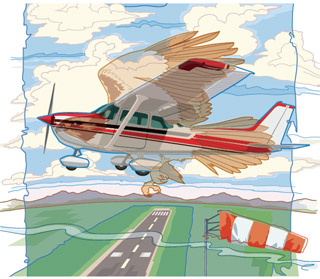 Slow flight is an essential skill for pilots to understand and master, but practicing it can be a drag (literally and figuratively). And the way we practice tends to make slow flight into a head-down chore. We do it by rote with eyes darting back and forth between the airspeed and vertical speed indicators, an activity that bears little resemblance to real-world situations in which we might actually encounter critically low airspeeds and high angles of attack—such as maneuvering in a traffic pattern while scanning for traffic.
Slow flight is an essential skill for pilots to understand and master, but practicing it can be a drag (literally and figuratively). And the way we practice tends to make slow flight into a head-down chore. We do it by rote with eyes darting back and forth between the airspeed and vertical speed indicators, an activity that bears little resemblance to real-world situations in which we might actually encounter critically low airspeeds and high angles of attack—such as maneuvering in a traffic pattern while scanning for traffic.
Making slow flight relevant requires getting your eyes focused outside the cockpit and keeping them there while adding tasks that demand flying by feel. The best game I know for this I call “Hover Like a Hawk.” We’ve all seen those remarkable kestrels that point themselves into the wind and hover at will over a ground-bound target. The challenge in this flying game is to imitate the kestrel with your airplane.
At a safe altitude, identify the wind direction and turn into it. Then slow down using landing gear, wing flaps, cowl flaps, and high propeller rpm—as appropriate—and take note of the GPS groundspeed. The goal in this exercise is to reduce groundspeed to the lowest possible value.
Once you’ve added all the parasitic drag, and then added enough power to maintain a constant altitude, there’s still much more to do. Can you spot any lateral drift? If so, the airplane isn’t pointed directly into the wind. Use smokestacks, wind lines on water, or any other external cues you can find to more precisely align your aircraft into the prevailing wind. If your glass panel is equipped with an air data computer that shows wind speed and direction, go ahead and use it—even though it’s more challenging to use external cues.
Check the GPS groundspeed and see if your wind corrections lower it. Then add engine power and raise the airplane’s nose. This raises induced drag and puts you behind the power curve and into the region of reverse command, in which more power is needed to fly slower. (This is why a hawk pumps its wings furiously during a hover.)
Additional engine power also increases P-factor and torque, so compensate for it with right rudder (and a hint of right aileron) while keeping your eyes outside and maintaining into-the-wind alignment. Glance at the GPS groundspeed and note how much slower it gets at higher power settings.
It’s common to inadvertently start climbing here, but in most piston aircraft the rise in induced drag from the increasing angle of attack will soon reduce or eliminate any climb. And if your airplane gains some altitude, note how the wind changes in speed or direction. (Any increase in lateral drift with an accompanying rise in GPS groundspeed should make such changes noticeable and quantifiable.)
Ideally, you’ll reach a point at which your airplane is pointed directly into the wind, at a constant altitude, with a high power setting, wing flaps down, cowl flaps open, landing gear down, the stall horn blaring. Your focus should remain far beyond the instrument panel to adjust for small shifts in wind direction; this requires smooth, subtle, and nearly constant corrections. The needle on the airspeed indicator should be at or near the bottom of the white arc, but don’t dwell on it. Keep focusing outside and flying by feel.
When the airflow starts to separate from the wings, lower the angle of attack momentarily, and then resume slow flight. If the airplane stalls, recover normally as you would from any other power-on stall. As you get better at this hovering game, keep a close watch on cylinder head temperatures. They tend to get hot in a hurry at high power settings with minimal amounts of cooling air.
On windy days in slow airplanes, you may be able to get the groundspeed down to zero, or even fly backwards. My personal best was a demo flight in a Carbon Cub in which Chip Allen, a CubCrafters dealer, had us flying at 15 knots in reverse—while 2,500 feet above Lakeland, Florida.
Hovering like a hawk enhances any pilot’s understanding of and appreciation for the ways in which airplanes behave differently at high angles of attack at various power settings. You’ll recognize the onset of a stall well before it actually happens, and you will recover instinctively without angst or drama. You’ll also become acutely aware of changes in wind speed and direction at altitude, and that will serve you well in all of your flying.
Email [email protected]



